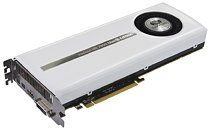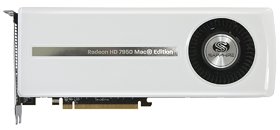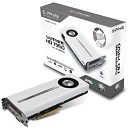Tuesday, March 19th 2013

Sapphire Launches Graphics Accelerator for Mac Pro
SAPPHIRE Technology, the leading manufacturer and global supplier of graphics solutions based on AMD technology, has just announced an exciting new graphics accelerator compatible with the Apple Mac Pro series of desktop computers.
Exclusive to SAPPHIRE, the HD 7950 Mac Edition is based on AMD's latest Graphics Core Next (GCN) architecture. This highly acclaimed architecture delivers a significant graphics performance boost for Mac Pro users in a wide range of applications including gaming, audio or video editing and content creation. For example, gaming frame rates are increased by over 200%, general benchmark performance increased by around 30% and graphics intensive benchmarks increased by as much as 300% compared with the NV 8800GT commonly used in these machines (SAPPHIRE internal data).The SAPPHIRE HD 7950 Mac Edition is equipped with 3 GB of the latest GDDR5 memory, and its Dual Asynchronous Compute Engines (ACE) deliver up to 2.87 TFLOPS Single Precision compute power. It provides hardware support for Open GL 4.2 and Open CL 1.2 as well as AMD HD3D technology and APP acceleration.
AMD's GCN architecture supports a number of advanced post-processing and scaling operations. These include de-blocking, de-noising, automatic de-interlacing, Mosquito noise reduction and edge enhancement as well as advanced image quality enhancement technology, such as adaptive anti-aliasing and 16x angle independent anisotropic texture filtering. The SAPPHIRE HD 7950 Mac Edition features AMD PowerPlay technology which provides automatic power management during operation and ensures low power consumption under idle conditions.
Flexible display support
Cutting-edge integrated display support includes two mini DisplayPort outputs with a maximum resolution of 3840 x 2160 per display under MacOS X. The card also features a 3 GHz HDMI 1.4a port. This output also supports a maximum resolution of 3840 x 2160.
Finally, there is a Dual-link DVI port with HDCP, which supports a maximum resolution of 2560 x 1600. As this is a DVI-I port it can also be used with the older style VGA monitors, with adapter supplied. The card supports two display outputs to be used at the same time, allowing dual monitor configurations to be used for increased productivity.
The SAPPHIRE HD 7950 Mac Edition is compatible with Apple Mac Pro models from 2010 and later with an available PCI-Express x16 slot. Two six-pin power cables required are supplied with the card. A driver disk is provided which enables the card to be used with Mac OS X 10.7.5 (Lion), 10.8.2 (Mountain Lion) or later.
The SAPPHIRE HD 7950 Mac Edition can also be used in the latest PC architectures. It has Dual Firmware support via a simple Firmware (Dual BIOS) switch. In one position the Sapphire HD 7950 MAC Edition supports Mac OS X/Windows under non-UEFI compliant mode and in the other it supports Windows with UEFI hybrid firmware enabled. A Windows driver disk is also included.
Under Windows, additional features are supported, including hardware acceleration of video decoding, HDMI audio pass through and additional display resolutions.
Exclusive to SAPPHIRE, the HD 7950 Mac Edition is based on AMD's latest Graphics Core Next (GCN) architecture. This highly acclaimed architecture delivers a significant graphics performance boost for Mac Pro users in a wide range of applications including gaming, audio or video editing and content creation. For example, gaming frame rates are increased by over 200%, general benchmark performance increased by around 30% and graphics intensive benchmarks increased by as much as 300% compared with the NV 8800GT commonly used in these machines (SAPPHIRE internal data).The SAPPHIRE HD 7950 Mac Edition is equipped with 3 GB of the latest GDDR5 memory, and its Dual Asynchronous Compute Engines (ACE) deliver up to 2.87 TFLOPS Single Precision compute power. It provides hardware support for Open GL 4.2 and Open CL 1.2 as well as AMD HD3D technology and APP acceleration.
AMD's GCN architecture supports a number of advanced post-processing and scaling operations. These include de-blocking, de-noising, automatic de-interlacing, Mosquito noise reduction and edge enhancement as well as advanced image quality enhancement technology, such as adaptive anti-aliasing and 16x angle independent anisotropic texture filtering. The SAPPHIRE HD 7950 Mac Edition features AMD PowerPlay technology which provides automatic power management during operation and ensures low power consumption under idle conditions.
Flexible display support
Cutting-edge integrated display support includes two mini DisplayPort outputs with a maximum resolution of 3840 x 2160 per display under MacOS X. The card also features a 3 GHz HDMI 1.4a port. This output also supports a maximum resolution of 3840 x 2160.
Finally, there is a Dual-link DVI port with HDCP, which supports a maximum resolution of 2560 x 1600. As this is a DVI-I port it can also be used with the older style VGA monitors, with adapter supplied. The card supports two display outputs to be used at the same time, allowing dual monitor configurations to be used for increased productivity.
The SAPPHIRE HD 7950 Mac Edition is compatible with Apple Mac Pro models from 2010 and later with an available PCI-Express x16 slot. Two six-pin power cables required are supplied with the card. A driver disk is provided which enables the card to be used with Mac OS X 10.7.5 (Lion), 10.8.2 (Mountain Lion) or later.
The SAPPHIRE HD 7950 Mac Edition can also be used in the latest PC architectures. It has Dual Firmware support via a simple Firmware (Dual BIOS) switch. In one position the Sapphire HD 7950 MAC Edition supports Mac OS X/Windows under non-UEFI compliant mode and in the other it supports Windows with UEFI hybrid firmware enabled. A Windows driver disk is also included.
Under Windows, additional features are supported, including hardware acceleration of video decoding, HDMI audio pass through and additional display resolutions.



23 Comments on Sapphire Launches Graphics Accelerator for Mac Pro
Edit: Where you thinking about this?Me too. I bet you that fan gets pretty loud when it starts ramping up though as squirrel cage fans do.
Some of us actually REALLY like this deisgn and may want one for out own PC to go with our other Black-White themed hardware.
Thanks. :)
For example. My HD 5770 is worth below 70~80€, but if I were to flash it with an Apple-compatible BIOS (Because there was a 5770 Mac version), I could easily get +100€ for it.
I dont understand why people are fine with paying premiums for performance but they whine about paying a premium for reliability. In fact, there's always been a much higher premium for reliability.
All I have to complain about apple is the price. Apple makes a good product and it doesn't need to be the fastest for it to do the job well. You don't need to overclock to have a machine do everything you want it to.
Go get an iMac with a 3770S and a 1440p display and tell me that it is slow and doesn't look nice.
The hardware is just as good as anything else, it's the price and the QA that Apple does with both the hardware and software together. By having a small set of devices Apple can tailor the OS to what it will be running on. Windows has to run on everything so it needs to be designed to run on everything.
All in all, Apple makes a good product, you just need to be prepared to pay out the nose for it because in all honesty, the OS X UI is clean, efficient, and just works and has worked for many years. Plenty of people will disagree with me and that's fine, but it's ignorant to say that Apple doesn't produce a good product.
So Sapphire knows they can only sell a relatively small number of these (with respect to standard PC versions) added with whatever requirements / certification / expense they had to go through to adhere to Apple specs,....of course it would have to cost more.
I'm just a little surprised that it wasn't launched with a new Mac Pro.
Don't much care about color though. To me color is one of the most irrelevant features of computer hardware.
I pretty much stated that apple products look good, perform well, and are very reliable.
>Mac edition
Why?
Also Apple doesn't need really fast machines to run their software well in a lot of cases. Since Apple keeps their own hardware on a tight leash, they can optimize the OS for a small set of hardware rather than everything which can reduce the footprint and improve performance.
All in all, Apple wasn't huge into performance because there is no money in it. They have several offerings but you need to really want them and have the money for them and in most cases it's not worth it, but that depends on how badly you want a Mac product over others.
over the 8800gt? well, great. isnt that card 6 years old or something along those lines? have there really been NO cards released for mac os since the 8800? if so, i feel bad for mac users....